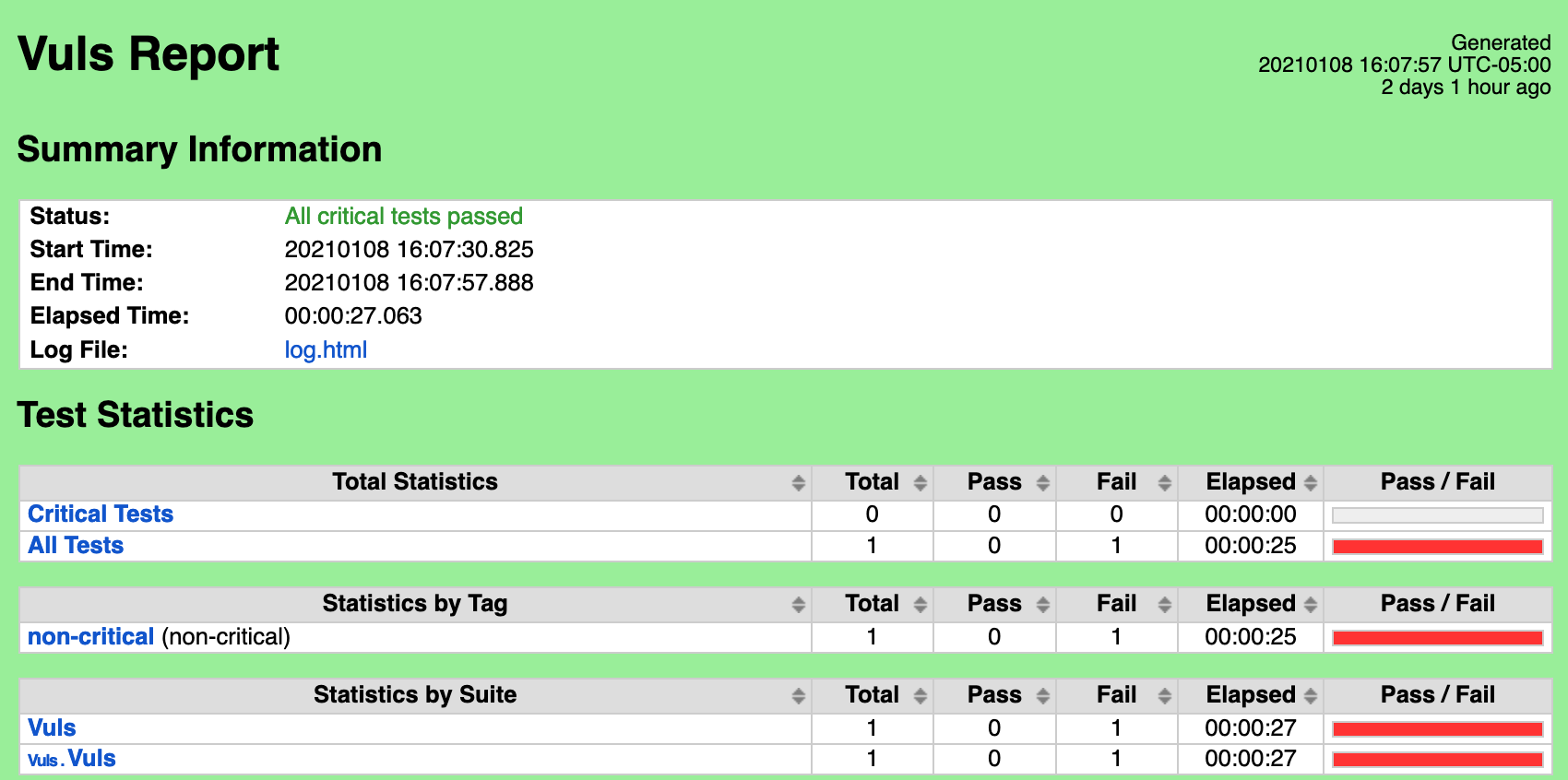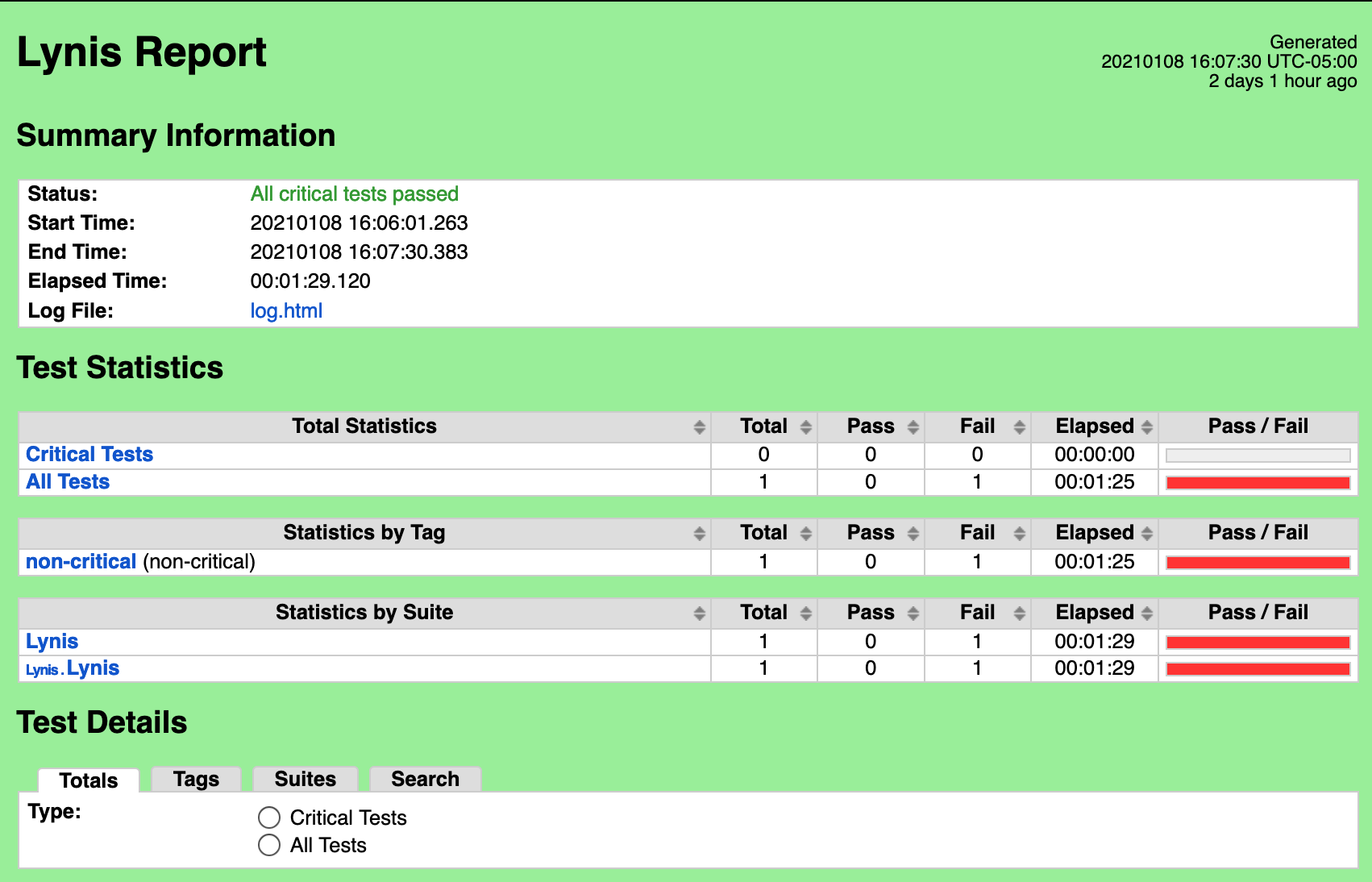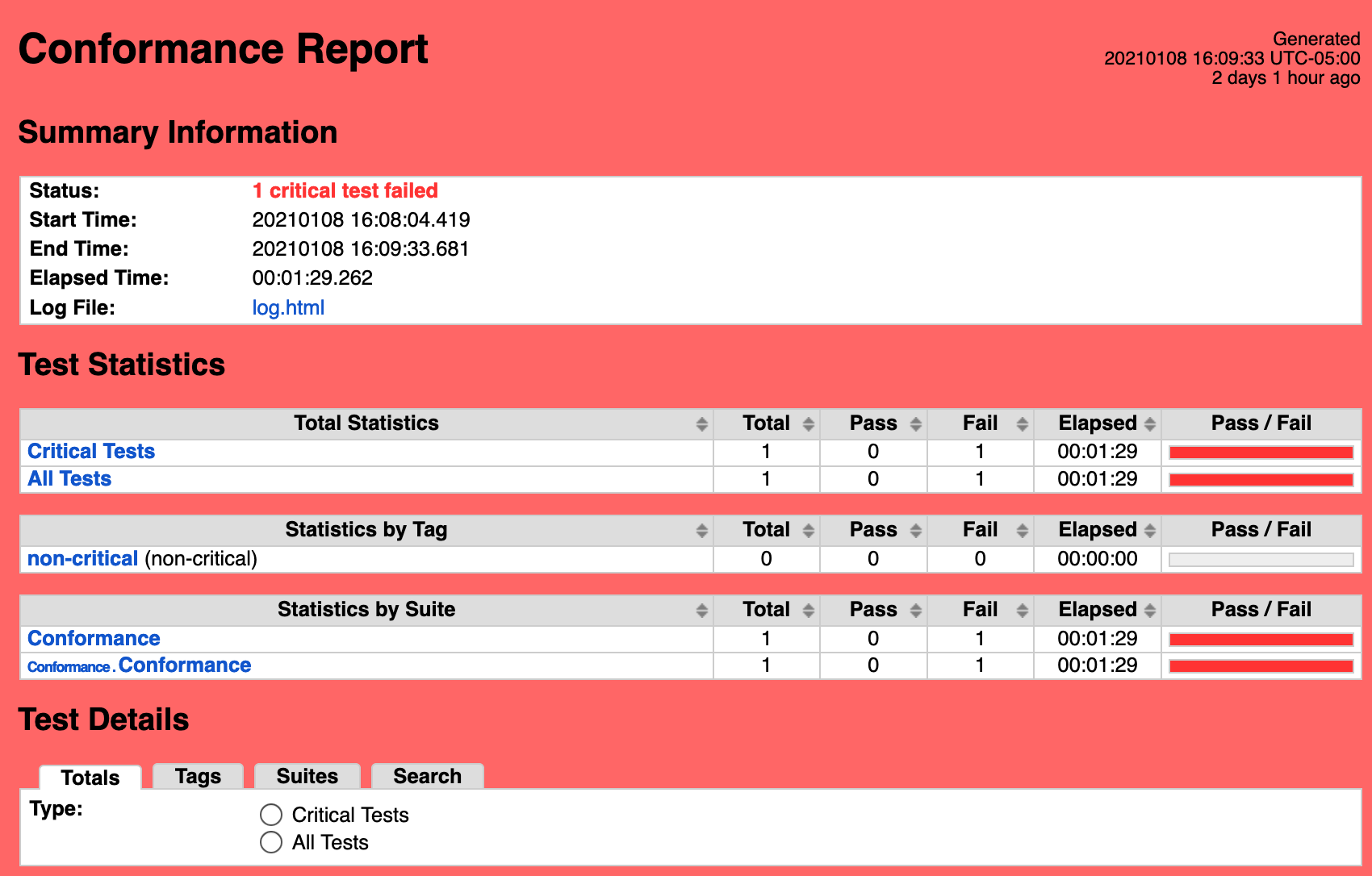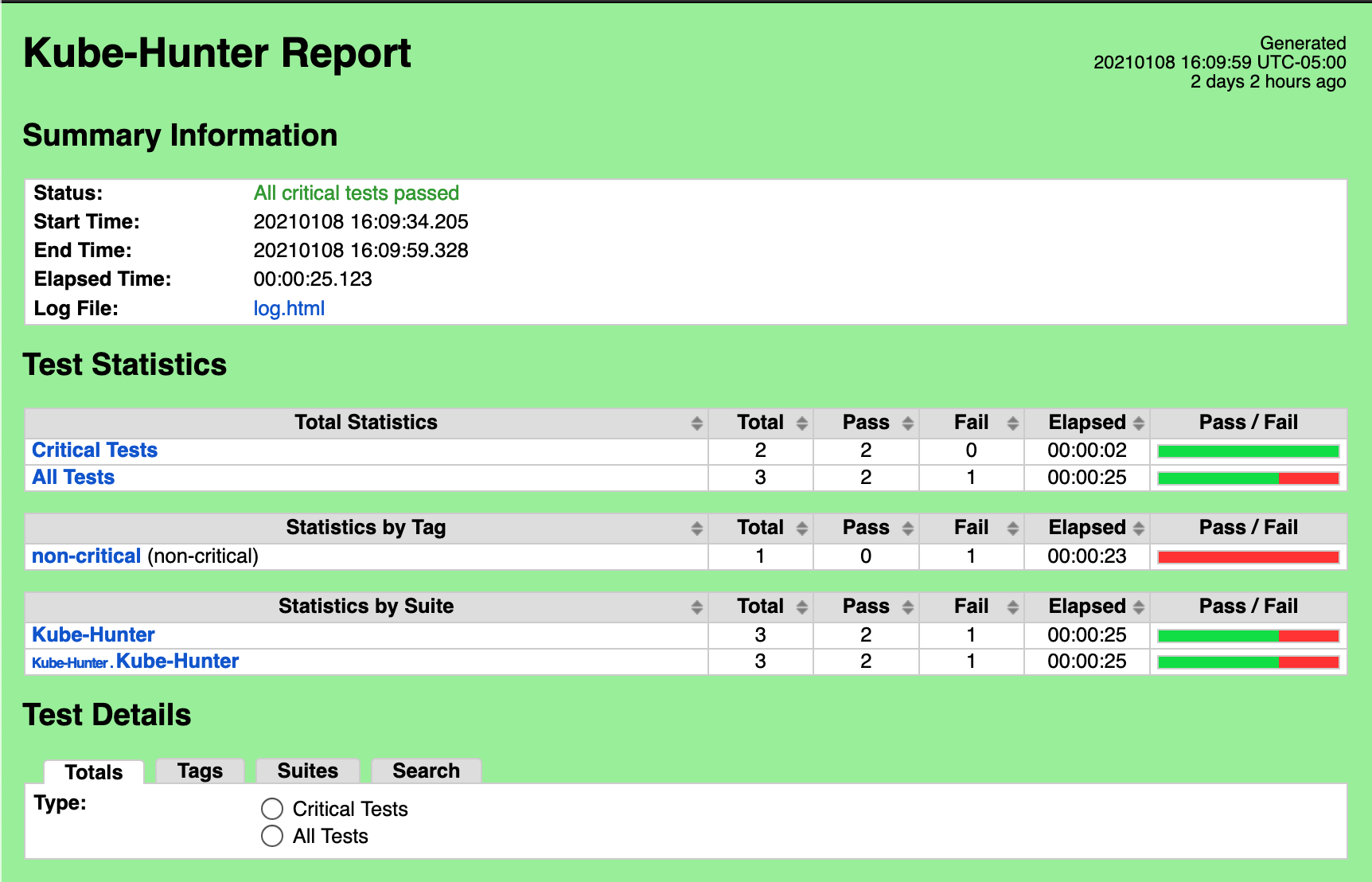Introduction
This document describes tests that were performed for PCEI R4:
- PCEI Deployment Tests
- PCEI End-to-End Validation Tests
- BluVal Tests
Overall Test Architecture
Describe the components of Test set up
Test Bed
Test Framework
- PCEI Deployment Tests
Described in the PCEI R4 Installation Guide
- PCEI End-to-End Validation Tests
Described in the PCEI R4 End-to-End Validation Guide
- BluVal Tests
Described in the BluVal Test section of this document.
Traffic Generator
Not used.
For end-to-end functional verification, a simulated IoT Client was provided. Please refer to PCEI R4 End-to-End Validation Guide.
Test API description
Akraino common tests
The Test inputs
Test Procedure
Expected output
Test Results
Blueprint extension tests
The Test inputs
Test Procedure
Expected output
Test Results
Feature Project Tests
NOT PERFORMED
The Test inputs
Test Procedure
Expected output
Test Results
BluVal Tests
The Test inputs
BluVal Test Environment setup according to:
Test Procedure
- Deploy a Test VM
- Install Docker: https://docs.docker.com/engine/install/ubuntu/
- Clone BluVal Validation Framework into the Test VM:
- Copy SUT's .kube/config file and SSH key to the Test VM
- Configure validation environment:
cd validation
vi bluval-pcei.yaml
blueprint:
name: pcei
layers:
- os
- docker
- k8s
# Any hardware some basic tests
os: &os_pcei
-
name: ltp
what: ltp
optional: "True"
-
name: cyclictest
what: cyclictest
optional: "True"
-
name: lynis
what: lynis
optional: "False"
-
name: vuls
what: vuls
optional: "False"
docker: &docker_base
-
name: docker_bench
what: docker_bench
optional: "True"
k8s: &k8s
-
name: conformance
what: conformance
optional: "False"
-
name: etcd_ha
what: etcd_ha
optional: "True"
-
name: kube-hunter
what: kube-hunter
optional: "False"
cd /home/onaplab/validation/bluval
vi volumes.yaml
volumes:
# location of the ssh key to access the cluster
ssh_key_dir:
local: '/home/onaplab/.ssh'
target: '/root/.ssh'
# location of the k8s access files (config file, certificates, keys)
kube_config_dir:
local: '/home/onaplab/kube'
target: '/root/.kube/'
# location of the customized variables.yaml
custom_variables_file:
local: '/home/onaplab/validation/tests/variables.yaml'
target: '/opt/akraino/validation/tests/variables.yaml'
# location of the bluval-<blueprint>.yaml file
blueprint_dir:
local: '/home/onaplab/validation/bluval'
target: '/opt/akraino/validation/bluval'
# location on where to store the results on the local jumpserver
results_dir:
local: '/home/onaplab/results'
target: '/opt/akraino/results'
# location on where to store openrc file
openrc:
local: ''
target: '/root/openrc'
# parameters that will be passed to the container at each layer
layers:
# volumes mounted at all layers; volumes specific for a different layer are below
common:
- custom_variables_file
- blueprint_dir
- results_dir
hardware:
- ssh_key_dir
os:
- ssh_key_dir
networking:
- ssh_key_dir
docker:
- ssh_key_dir
k8s:
- ssh_key_dir
- kube_config_dir
k8s_networking:
- ssh_key_dir
- kube_config_dir
openstack:
- openrc
sds:
sdn:
vim:
cd /home/onaplab/validation/tests
vi variables.yaml
### Input variables cluster's master host
host: 10.121.7.147 # cluster's master host address
username: onaplab # login name to connect to cluster
password: onaplab # login password to connect to cluster
ssh_keyfile: /root/.ssh/id_rsa # Identity file for authentication
6. Run BluVal Robot:
cd bash validation/bluval/blucon.sh pcei
Expected output
Test Results
Vuls
CVEs Found:
| CVE | CVSS | URL | Exception |
|---|---|---|---|
| CVE-2016-1585 | 9.8 | https://nvd.nist.gov/vuln/detail/CVE-2016-1585 | Requested by another BP |
| CVE-2017-18342 | 9.8 | https://nvd.nist.gov/vuln/detail/CVE-2017-18342 | Requested by another BP |
| CVE-2017-8283 | 9.8 | https://nvd.nist.gov/vuln/detail/CVE-2017-8283 | Requested by PCEI |
| CVE-2018-20839 | 9.8 | https://nvd.nist.gov/vuln/detail/CVE-2018-20839 | Requested by another BP |
| CVE-2019-17041 | 9.8 | https://nvd.nist.gov/vuln/detail/CVE-2019-17041 | Requested by another BP |
| CVE-2019-17042 | 9.8 | https://nvd.nist.gov/vuln/detail/CVE-2019-17042 | Requested by another BP |
| CVE-2019-19814 | 9.3 | https://nvd.nist.gov/vuln/detail/CVE-2019-19814 | Requested by PCEI |
Lynis
K8S Conformance
Exception Requested:
Kube-Hunter
Vulnerabilities found
| ID | Status |
|---|---|
| KHV002 | Fixed |
| KHV005 | Pending |
| KHV050 | Pending |
| CAP_NET_RAW | Pending |
Fix for KHV002:
On SUT K8S Cluster:
kubectl replace -f - <<EOF
apiVersion: rbac.authorization.k8s.io/v1
kind: ClusterRole
metadata:
annotations:
rbac.authorization.kubernetes.io/autoupdate: "false"
labels:
kubernetes.io/bootstrapping: rbac-defaults
name: system:public-info-viewer
rules:
- nonResourceURLs:
- /healthz
- /livez
- /readyz
verbs:
- get
EOF
Test Dashboards
Single pane view of how the test score looks like for the Blue print.





